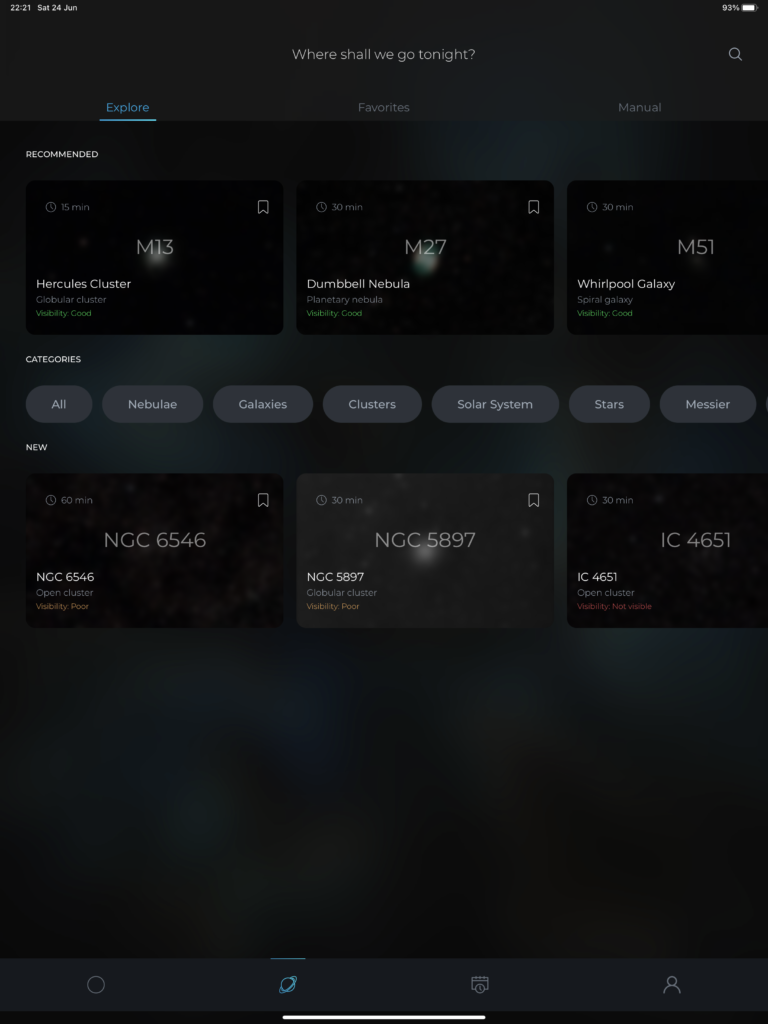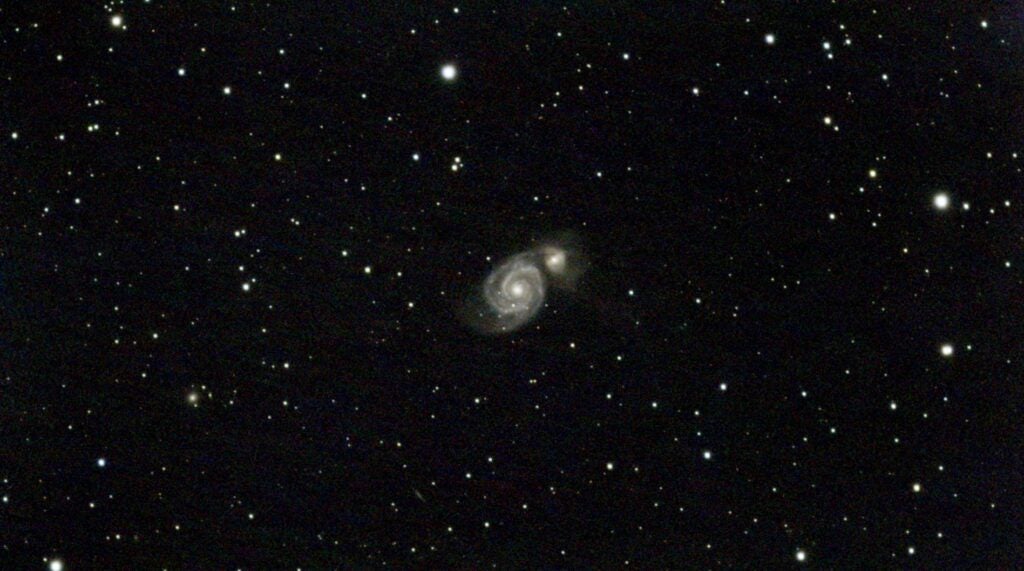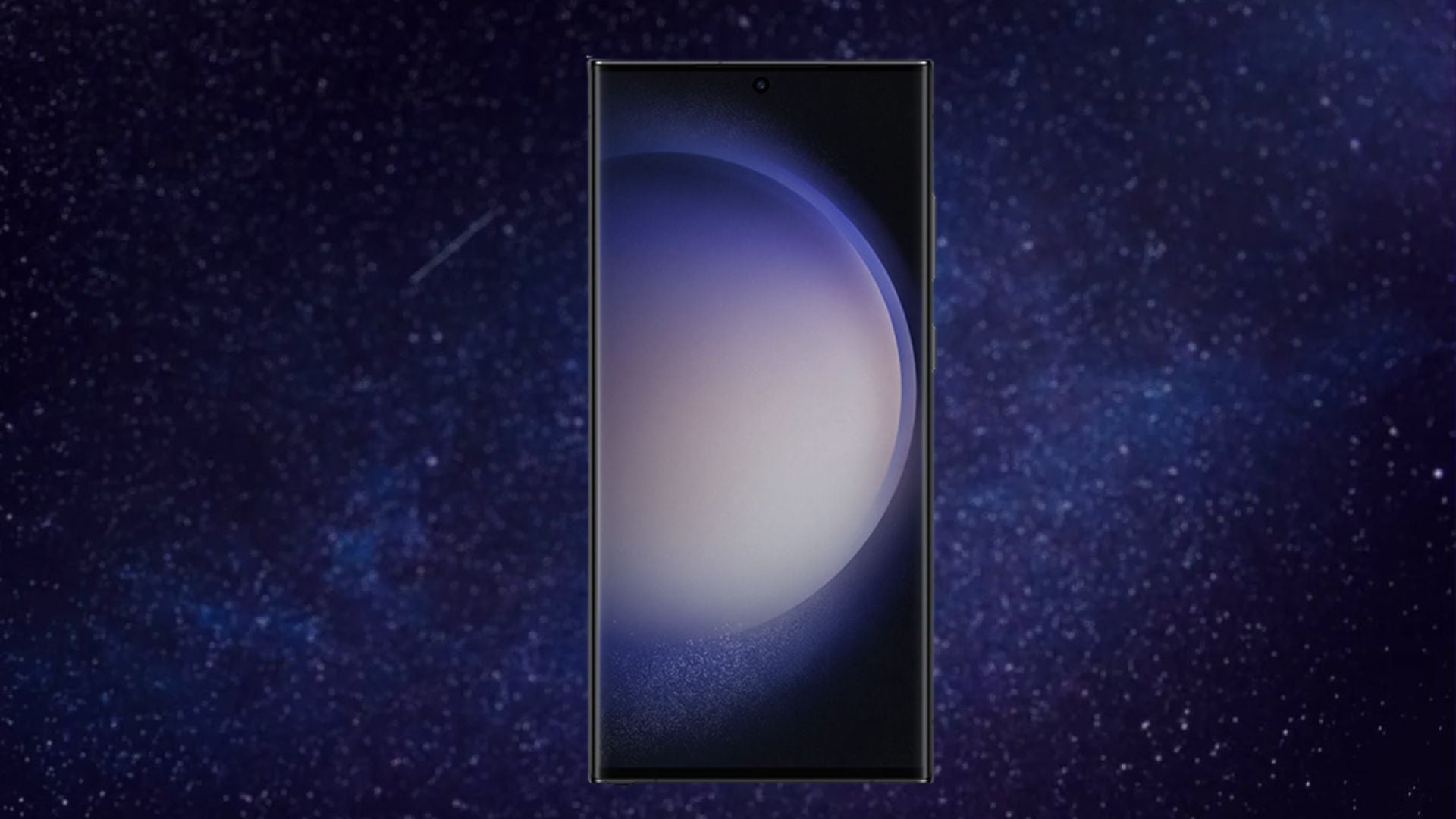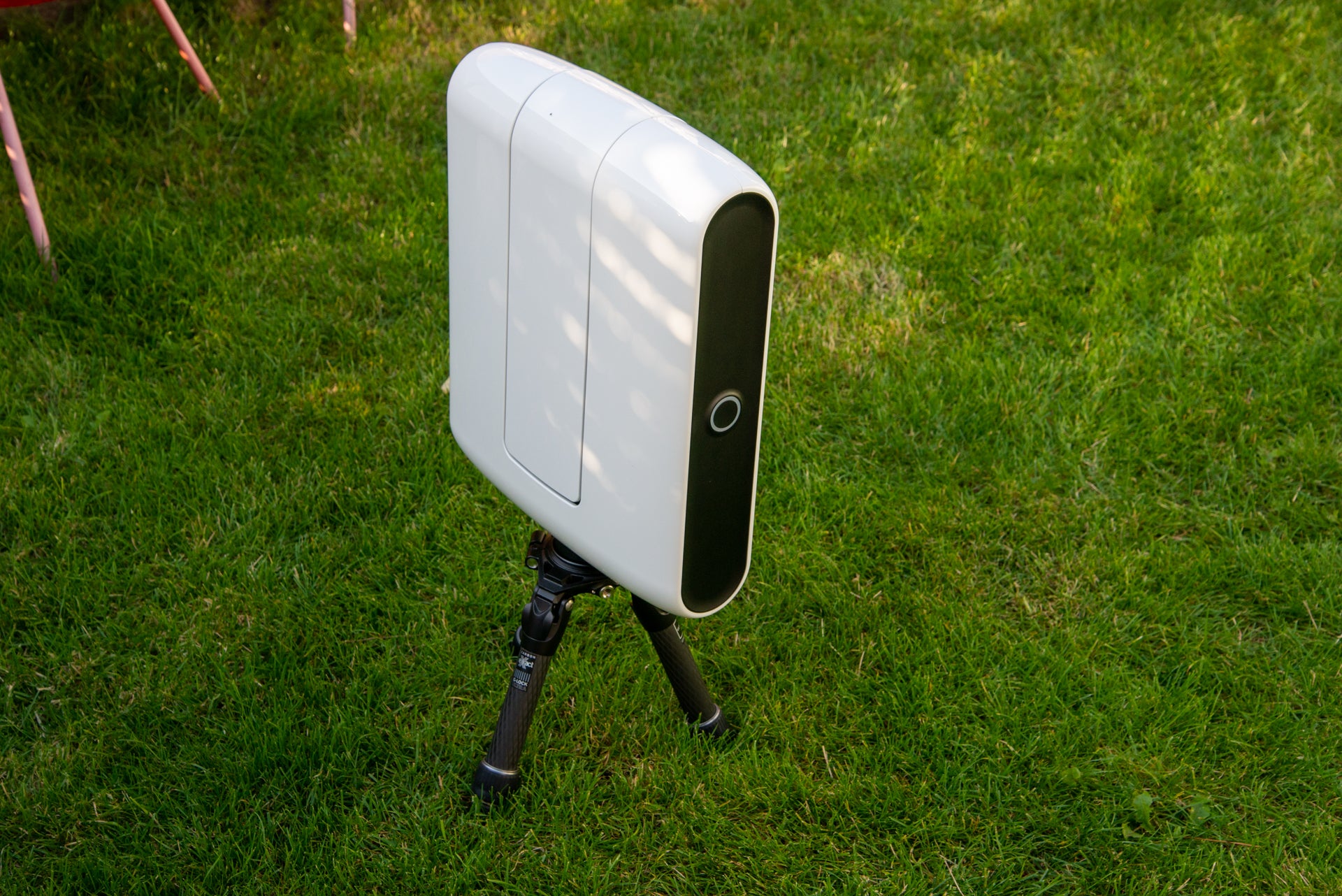Verdict
A small and beautifully designed combination of camera and lens that can find and track objects in the night sky while sending images to a connected phone or tablet, the Vaonis Vespera takes a lot of the hard work out of astrophotography and stargazing in general. Despite the small size of its images, it’s fully capable of revealing distant galaxies and other deep-sky objects, and it opens up the wonders of the universe.
Pros
- Simple to use
- Comprehensive catalogue of objects
- Great design
Cons
- Results can be disappointing
- Needs careful positioning
- Quite expensive
-
CameraUses a 2MP sensor with autofocus -
Automatic star findingUses GPS and software to automatically lock onto objects in the night sky.
Introduction
The smaller sibling of the Vaonis Stellina we reviewed in 2021, the Vespera is a compact, automated platform for finding and imaging deep-sky objects that we otherwise couldn’t see. Galaxies, nebulae and clusters are all within its reach, as are the planets, just about, and with an optional solar filter you can keep an eye on sunspots and prominences too.
The files produced by the Vespera are small, and it suffers from image noise, but the excitement of being able to see another galaxy from even a light-polluted suburban back garden is unsurpassed.
Design and features
- Looks like it comes from outer space
- Compact and easy to transport
- Easy to set up
If you’ve ever played Portal 2, then there’s something about the Vespera that’s reminiscent of that game’s gun turrets. Luckily it’s unlikely to pepper you with plasma bolts, as the Vespera is more interested in photons, specifically those emitted by deep sky objects.

It looks completely futuristic, and anyone not in the know about its purpose is unlikely to guess when looking at it in its closed position.
All that breaks the smooth surface is a circular light-rimmed button you’ll use to set up the wireless network, and a clever magnetic charging port like a MacBook’s MagSafe (its cable plugs into a USB-C port) that also attaches a bubble level to make sure it’s on a flat surface.
The arm that contains the optics rotates out of its storage position to look at the sky, and it all balances on a tiny tripod with adjustable legs, though there’s a standard tripod head attachment underneath, so you can give it longer legs if needed.

Those legs are important, because the key to setting the Vespera up is to get it level. Once it’s level, and dark enough – that’s important too – it will calibrate itself using star recognition and set up a Wi-Fi link to your phone, from which it can use GPS data.
It creates its own hotspot rather than connecting through a router, meaning you can use it out in the wilds miles away from the nearest network. Weighing less than 5KG and with a battery that will power it for four hours or more, the Vespera is a great little thing to pack up and take with you to escape the city lights. Mine even came with a matching backpack.
It’s easy to call the Vespera a telescope, but with its 50mm aperture and 33x magnification it’s really one half of a pair of binoculars with a camera (a 1/2.8-inch Sony IMX462 sensor that produces 2MP images) attached. This isn’t a criticism as such, but compared to the best telescopes out, it’s really very small. Astrophotography is all about capturing light, as much as possible, and having a larger instrument naturally lets more light in.

Performance
- Simple to use
- Highly automated
- Results can vary
To home in on a night-sky object you want to inspect with the Vespera, you’ll need to use the Vaonis app, called Singularity.
This contains a catalogue of over 300 objects the telescope can find – as long as they’re in the sky above it, and there’s nothing like overhanging trees or clouds in the way. The app will tell you the availability of objects, when they’ll rise or whether they’re visible all night, but it’s up to you to keep an eye on the weather and where you’ve placed the scope.

Thanks to the point-to-point Wi-Fi connection, it’s possible to sit indoors or in a car to get out of the cold and leave the Vespera to it. Once you’ve picked your target in the app, it commands the Vespera to slew its scope around to find it. We found it generally accurate as long as it had a clear view of the sky, producing an error message whenever something got in its line of sight. The camera works through the image-stacking technique, meaning it takes many images and combines them while tracking its target, assembling a picture out of the light it captures over periods of time.
Some brighter objects – bright is a relative term when discussing deep sky objects invisible to the naked eye – may take 15 minutes to coalesce into a reasonable picture, while others may take much longer, and the app tells you this up front, but you’re usually able to make out what you’re looking at pretty soon after you begin observing.
Given the low resolution of the sensor and the lack of magnification, objects such as galaxies and globular clusters appear small in the centre of the frame. Larger objects such as nebulae can fill it, but the amount of time you’ll need to spend observing these is greater, as they emit much less light. It’s also not something you can adjust manually, as the need for calibration means you need to wait until it is dark enough to detect stars, and can’t manually move the arm to inspect and photograph the moon while you’re waiting. In the middle of summer, the short hours of darkness are not conducive to easy observing, so this may become a hobby best enjoyed on the cooler, crisper nights of autumn and spring.
The images you get via the app can be very noisy, with a lack of definition. Despite this, they also have the potential to be stunning, as anything that reveals the beauty of the cosmos does. It’s possible to connect to the Vespera as an FTP server, and download image files from its internal storage if you fancy having a go at processing yourself, but it’s easier to let the app’s own algorithms do the work.
My images of the Whirlpool Galaxy and its companion NGC 5195 (30 million lightyears away), plus the Hercules Globular Cluster (25,000 lightyears away), taken from an out-of-town garden with Bortle 4 skies on a summer night, show some definition, particularly in the galaxy’s spiral arms, but the centre of the cluster sees the stars merge into a patch of white. Images on the Vaonis website show what’s possible when using its telescopes, however, so taking it to a dark sky reserve and really putting in the hours may pay dividends.
The great benefit of the Vespera is its automatic nature. Astrophotography can be a frustrating hobby that can see you spend thousands on equipment and stay up all night, only to produce nothing, so having an automated scope that connects to your phone is a great benefit to anyone interested in what’s up there.

Latest deals
Should you buy it?
You’re looking for an easy entry point to the world of deep-sky imaging: The automated photography makes night-sky photography easy.
You’re expecting the Hubble telescope in your back garden: This is not as powerful as many traditional telescopes.
Final Thoughts
The Vespera is incredibly easy to use, and breaks down a lot of the barriers that stand in the way of enjoying the stunning objects that lurk in our night skies.
If you’ve got a hankering to know what’s up there, this is the ideal gateway, but the noisy quality of the images it produces, and the amount of time you’ll need to spend gathering them, may surprise you.
Like all telescopes, it’s best used away from the city lights, but even if you’re surrounded by streetlamps it’s capable of revealing the wonders of the universe. Beware, though, it might be the beginning of a life-long addiction.
FAQs
No, it has to be controlled through the app.
It creates its own Wi-Fi hotspot.
Verdict
A small and beautifully designed combination of camera and lens that can find and track objects in the night sky while sending images to a connected phone or tablet, the Vaonis Vespera takes a lot of the hard work out of astrophotography and stargazing in general. Despite the small size of its images, it’s fully capable of revealing distant galaxies and other deep-sky objects, and it opens up the wonders of the universe.
Pros
- Simple to use
- Comprehensive catalogue of objects
- Great design
Cons
- Results can be disappointing
- Needs careful positioning
- Quite expensive
-
CameraUses a 2MP sensor with autofocus -
Automatic star findingUses GPS and software to automatically lock onto objects in the night sky.
Introduction
The smaller sibling of the Vaonis Stellina we reviewed in 2021, the Vespera is a compact, automated platform for finding and imaging deep-sky objects that we otherwise couldn’t see. Galaxies, nebulae and clusters are all within its reach, as are the planets, just about, and with an optional solar filter you can keep an eye on sunspots and prominences too.
The files produced by the Vespera are small, and it suffers from image noise, but the excitement of being able to see another galaxy from even a light-polluted suburban back garden is unsurpassed.
Design and features
- Looks like it comes from outer space
- Compact and easy to transport
- Easy to set up
If you’ve ever played Portal 2, then there’s something about the Vespera that’s reminiscent of that game’s gun turrets. Luckily it’s unlikely to pepper you with plasma bolts, as the Vespera is more interested in photons, specifically those emitted by deep sky objects.

It looks completely futuristic, and anyone not in the know about its purpose is unlikely to guess when looking at it in its closed position.
All that breaks the smooth surface is a circular light-rimmed button you’ll use to set up the wireless network, and a clever magnetic charging port like a MacBook’s MagSafe (its cable plugs into a USB-C port) that also attaches a bubble level to make sure it’s on a flat surface.
The arm that contains the optics rotates out of its storage position to look at the sky, and it all balances on a tiny tripod with adjustable legs, though there’s a standard tripod head attachment underneath, so you can give it longer legs if needed.

Those legs are important, because the key to setting the Vespera up is to get it level. Once it’s level, and dark enough – that’s important too – it will calibrate itself using star recognition and set up a Wi-Fi link to your phone, from which it can use GPS data.
It creates its own hotspot rather than connecting through a router, meaning you can use it out in the wilds miles away from the nearest network. Weighing less than 5KG and with a battery that will power it for four hours or more, the Vespera is a great little thing to pack up and take with you to escape the city lights. Mine even came with a matching backpack.
It’s easy to call the Vespera a telescope, but with its 50mm aperture and 33x magnification it’s really one half of a pair of binoculars with a camera (a 1/2.8-inch Sony IMX462 sensor that produces 2MP images) attached. This isn’t a criticism as such, but compared to the best telescopes out, it’s really very small. Astrophotography is all about capturing light, as much as possible, and having a larger instrument naturally lets more light in.

Performance
- Simple to use
- Highly automated
- Results can vary
To home in on a night-sky object you want to inspect with the Vespera, you’ll need to use the Vaonis app, called Singularity.
This contains a catalogue of over 300 objects the telescope can find – as long as they’re in the sky above it, and there’s nothing like overhanging trees or clouds in the way. The app will tell you the availability of objects, when they’ll rise or whether they’re visible all night, but it’s up to you to keep an eye on the weather and where you’ve placed the scope.

Thanks to the point-to-point Wi-Fi connection, it’s possible to sit indoors or in a car to get out of the cold and leave the Vespera to it. Once you’ve picked your target in the app, it commands the Vespera to slew its scope around to find it. We found it generally accurate as long as it had a clear view of the sky, producing an error message whenever something got in its line of sight. The camera works through the image-stacking technique, meaning it takes many images and combines them while tracking its target, assembling a picture out of the light it captures over periods of time.
Some brighter objects – bright is a relative term when discussing deep sky objects invisible to the naked eye – may take 15 minutes to coalesce into a reasonable picture, while others may take much longer, and the app tells you this up front, but you’re usually able to make out what you’re looking at pretty soon after you begin observing.
Given the low resolution of the sensor and the lack of magnification, objects such as galaxies and globular clusters appear small in the centre of the frame. Larger objects such as nebulae can fill it, but the amount of time you’ll need to spend observing these is greater, as they emit much less light. It’s also not something you can adjust manually, as the need for calibration means you need to wait until it is dark enough to detect stars, and can’t manually move the arm to inspect and photograph the moon while you’re waiting. In the middle of summer, the short hours of darkness are not conducive to easy observing, so this may become a hobby best enjoyed on the cooler, crisper nights of autumn and spring.
The images you get via the app can be very noisy, with a lack of definition. Despite this, they also have the potential to be stunning, as anything that reveals the beauty of the cosmos does. It’s possible to connect to the Vespera as an FTP server, and download image files from its internal storage if you fancy having a go at processing yourself, but it’s easier to let the app’s own algorithms do the work.
My images of the Whirlpool Galaxy and its companion NGC 5195 (30 million lightyears away), plus the Hercules Globular Cluster (25,000 lightyears away), taken from an out-of-town garden with Bortle 4 skies on a summer night, show some definition, particularly in the galaxy’s spiral arms, but the centre of the cluster sees the stars merge into a patch of white. Images on the Vaonis website show what’s possible when using its telescopes, however, so taking it to a dark sky reserve and really putting in the hours may pay dividends.
The great benefit of the Vespera is its automatic nature. Astrophotography can be a frustrating hobby that can see you spend thousands on equipment and stay up all night, only to produce nothing, so having an automated scope that connects to your phone is a great benefit to anyone interested in what’s up there.

Latest deals
Should you buy it?
You’re looking for an easy entry point to the world of deep-sky imaging: The automated photography makes night-sky photography easy.
You’re expecting the Hubble telescope in your back garden: This is not as powerful as many traditional telescopes.
Final Thoughts
The Vespera is incredibly easy to use, and breaks down a lot of the barriers that stand in the way of enjoying the stunning objects that lurk in our night skies.
If you’ve got a hankering to know what’s up there, this is the ideal gateway, but the noisy quality of the images it produces, and the amount of time you’ll need to spend gathering them, may surprise you.
Like all telescopes, it’s best used away from the city lights, but even if you’re surrounded by streetlamps it’s capable of revealing the wonders of the universe. Beware, though, it might be the beginning of a life-long addiction.
FAQs
No, it has to be controlled through the app.
It creates its own Wi-Fi hotspot.

























